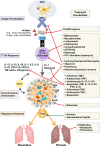Treatment of Sarcoidosis: A Multidisciplinary Approach
- PMID: 33329511
- PMCID: PMC7732561
- DOI: 10.3389/fimmu.2020.545413
Treatment of Sarcoidosis: A Multidisciplinary Approach
Abstract
Sarcoidosis is a systemic disease of unknown etiology defined by the presence of noncaseating granulomatous inflammation that can cause organ damage and diminished quality of life. Treatment is indicated to protect organ function and decrease symptomatic burden. Current treatment options focus on interruption of granuloma formation and propagation. Clinical trials guiding evidence for treatment are lacking due to the rarity of disease, heterogeneous clinical course, and lack of prognostic biomarkers, all of which contribute to difficulty in clinical trial design and implementation. In this review, a multidisciplinary treatment approach is summarized, addressing immunuosuppressive drugs, managing complications of chronic granulomatous inflammation, and assessing treatment toxicity. Discovery of new therapies will depend on research into pathogenesis of antigen presentation and granulomatous inflammation. Future treatment approaches may also include personalized decisions based on pharmacogenomics and sarcoidosis phenotype, as well as patient-centered approaches to manage immunosuppression, symptom control, and treatment of comorbid conditions.
Keywords: drug-related side effects and adverse reactions; granuloma; immunosuppression; sarcoidosis; therapeutics; treatment outcome.
Copyright © 2020 Gerke.
Conflict of interest statement
The author declares that the research was conducted in the absence of any commercial or financial relationships that could be construed as a potential conflict of interest.
Figures


References
Publication types
MeSH terms
Substances
LinkOut - more resources
Full Text Sources
Other Literature Sources
Medical

